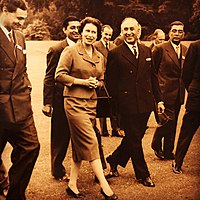Nazir Ahmed (physicist)
Nazir Ahmed | |
|---|---|
 Ahmed (right) with Queen Elizabeth II | |
| Born | 1 May 1898 |
| Died | 30 September 1973 (aged 75) |
| Nationality | Pakistani |
| Alma mater | Muhammadan Anglo-Oriental College, British India University of Cambridge, UK |
| Known for | Nuclear power generation programme |
| Awards | Gold Medal from Pakistan Academy of Sciences |
| Scientific career | |
| Fields | Experimental Physics |
| Institutions | Pakistan Atomic Energy Commission (PAEC), Technological Laboratory, India Federal Bureau of Statistics |
| Doctoral advisor | Ernest Rutherford[citation needed] |
| Influences | Ernest Rutherford[citation needed] |
Nazir Ahmed (or Nazir Ahmad), OBE (1 May 1898 – 30 September 1973) was a Pakistani experimental physicist and the first chairman of the Pakistan Atomic Energy Commission (PAEC) from 1956 to 1960.[1]
Life[]
Nazir Ahmed was born in a Kakazai family.[2][3] Ahmed obtained his B.Sc. in physics from Muhammadan Anglo-Oriental College, Aligarh, India in 1919.[4] He attended the University of Cambridge, UK, under the supervision of Ernest Rutherford.[4] There he received his M.Sc. in 1923, and PhD in experimental physics in 1925.[4]
In 1930, Nazir Ahmed came back to India, where he was appointed assistant director at the Technological Laboratory, Central Cotton Committee of India, and became its director after one year.[4] While living in Bombay, he married Razia, a member of the Khader Nawaz Khan family of Madras and the Carnatic Sultanate; her sister Rafia married Ahmed's friend, the naval officer HMS Choudri.
On June 9, 1938, George VI appointed Ahmed an Officer of the Most Excellent Order of the British Empire.
In 1945, Ahmed was appointed member of the Indian Tariff Board.[4]
After the partition of India, Ahmed migrated to Karachi in Pakistan, where he held various positions, such as joint secretary of the Ministry of Economic Affairs and the Pakistan Development Board.[4] In 1956, he became the first chairman of the Pakistan Atomic Energy Commission (PAEC), a post he held until 1960.[4][5]
Nazir Ahmed was involved in efforts to build a heavy water plant at Multan, but the Pakistan Industrial Development Corporation turned down his request.[6] In 1960, he was transferred to Ministry of Science and Technology under the administration of President Ayub Khan.
Fellowships[]
- A 'Fellow' of the Pakistan Academy of Sciences (1953-1970).[7]
Award named after Nazir Ahmad[]
- To honor his services, Dr. Nazir Ahmad Award was named after him by the Pakistan Academy of Sciences.
Research papers[]
- Tubewell Theory and Practice, published by Pakistan Academy of Sciences - (Nazir Ahmed) (1979).[8]
- Survey of Fuels & Electric Power Resources in Pakistan, published by Pakistan Academy Of Sciences - (Nazir Ahmed) (1972).[8]
References[]
- ^ Adeel Khan (7 June 2001). "History of Pakistan's Nuclear Power Industry". Ryerson University website. Retrieved 6 May 2020.
- ^ Sheikh, Majid (22 October 2017). "The history of Lahore's Kakayzais". DAWN.COM. Retrieved 28 February 2018.
- ^ Rahi, Arwin (25 February 2020). "Why Afghanistan should leave Pakistani Pashtuns alone". The Express Tribune (Opinion). Archived from the original on 3 May 2020. Retrieved 26 June 2020.
- ^ Jump up to: a b c d e f g I.H. Qureshi (2005). "Recollection from the early days of the PAEC (Pakistan Atomic Energy Commission)" (PDF). The Nucleus (journal). 42 (1–2): 7–11 (PDF). Retrieved 6 May 2020. Check
|archive-url=value (help) - ^ A. Gill (2006). "Pakistani Nuclear Program 1-5". Owl's Tree website. Retrieved 6 May 2020.
- ^ "Pakistan: Nuclear Chronology (1953-1970): March 1958". Nuclear Threat Initiative website. 2005. Archived from the original on 8 October 2008. Retrieved 6 May 2020.
- ^ 'Deceased Fellows List' of the Pakistan Academy Of Sciences Pakistan Academy Of Sciences website, Retrieved 6 May 2020
- ^ Jump up to: a b Nazir Ahmed's research paper publications from 1972 and 1979 on Pakistan Academy Of Sciences website Retrieved 6 May 2020
- 1898 births
- 1973 deaths
- Pashtun people
- Pakistani physicists
- Pakistani scientists
- Pakistani scholars
- Alumni of the Victoria University of Manchester
- Aligarh Muslim University alumni
- Science and technology in Pakistan
- Fellows of Pakistan Academy of Sciences
- Chairpersons of the Pakistan Atomic Energy Commission